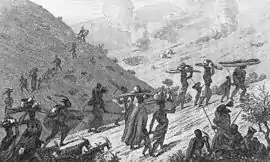Matiwane
Matiwane (died c.1830, uMgungundlovu), son of Masumpa, was the chief of an independent Nguni-speaking tribe, the amaNgwane,[1] a people named after Matiwane's ancestor Ngwane. The amaNgwane lived at the headwaters of the White Umfolozi, in what is now northern KwaZulu-Natal. The cunning of Matiwane would keep the amaNgwane one step ahead of the ravages of the rising Zulu kingdom, but their actions also set the Mfecane in motion. After Matiwane's tribe was ousted from their homeland by Zwide or Shaka, they preyed on neighboring tribes and became vagrant marauders. They were eventually checked by an alliance of colonial and tribal troops, some of whom were refugees from Matiwane's earlier exploits. As a refugee Matiwane was at the mercy of the Basutos and Swazis, but eventually had to seek refuge with king Dingane, successor to Shaka. This despotic ruler put Matiwane to death shortly after Matiwane sought his protection.

Migrations
Expecting an attack on his homeland, Matiwane moved some of his cattle herds westward. Soon afterwards, in 1817 or 1818, either Zwide[2] or Shaka serving as Dingiswayo's general, attacked and plundered the amaNgwane and drove them across the Buffalo river. This was the onset of the Mfecane migrations in which tribes became displaced, and in turn displaced others in a series of internecine wars.[1]
The destitute amaNgwane under Matiwane's leadership moved westwards, where they attacked the Hlubi, a larger kingdom built by Bhungane, in a quest to recover their cattle.[2] Matiwane's patrols trapped and killed their chief Mthimkhulu c.1818, causing the Hlubi tribe to scatter in different directions. Some Hlubi abandoned their homeland and fled north or west, or joined Shaka,[2] but some merged with the amaNgwane. Still others joined a coalition of refugees, the Fengu, who settled on the eastern frontier of the Cape Colony.[3] The Hlubi rued this catastrophe, referring to it as the izwekufa ("country of death"), and ascribed it to an act of witchcraft.
For the next three to four years Matiwane became the overlord of the upper Thukela region, near present-day Bergville, as he incorporated smaller tribes like the Bhele (relations of the Hlubi) and Zizi.[4]
In 1821 or 1822 Matiwane, expecting an attack from Shaka, fled over the Drakensberg and drove the Tlokwa tribe of chieftainess Mantatese (mother of Sekonyela) from their land in the Harrismith-Vrede region. Sotho tribes of the interior were also attacked, who fled to the region of Lesotho, where they joined the ranks of Moshoeshoe I.[3] When Matiwane turned south and threatened Moshoeshoe I, he sought the protection of Shaka and sent him tribute.[1] Matiwane established himself at Mabolela hill, near present day Clocolan, and Moshoeshoe complained to Shaka that this prevented him from sending tribute. Shaka dispatched Moselekatse to attack Matiwane, who had to retreat before the impi's advance. They fled southwards to the lands of the Umtata tribe, which they once again plundered. Matiwane became a fugitive again in 1828, when his people were defeated by colonial troops under the command of Major Dundas and Colonel Somerset.[1]
Death
Dingane allowed his residence on the Hlomo amabutho ridge, less than a kilometer from his royal kraal uMgungundlovu, but before long had him killed. Dingane posthumously appointed him as the "devil chief" and "great chief of the wicked",[1] and had scores of his own enemies executed at KwaMatiwane, the Place of Matiwane.
References
- Kotzé, D. J. (1950). Letters of the American Missionaries, 1835-1838. Cape Town: Van Riebeeck Society. pp. 223–224.
- Etherington, Norman (2001). The great treks: the transformation of Southern Africa, 1815-1854. New York: Longman. ISBN 0582315670.
- Atlas of Southern Africa. Reader's Digest. August 1985. p. 27. ISBN 0-947008-02-0.
- Giliomee, H.; et al. "How did the Mfecane begin?". New History of South Africa. Retrieved 8 July 2014.

